- 1Department of Kinesiology, University of Waterloo, Waterloo, ON, Canada
- 2Conselho Nacional de Desenvolvimento Científico e Tecnológico (CNPq), Brasília, Brazil
- 3Department of Physiotherapy, Universidade Ibirapuera, São Paulo, Brazil
- 4Schlegel-University of Waterloo Research Institute for Aging, Waterloo, ON, Canada
The temporal dynamics of the oxygen uptake () during moderate exercise has classically been related to physical fitness and a slower dynamics was associated with deterioration of physical health. However, methods that better characterize the aerobic system temporal dynamics remain challenging. The purpose of this study was to develop a new method (named mean normalized gain, MNG) to systematically characterize the temporal dynamics. Eight healthy, young adults (28 ± 6 years old, 175 ± 7 cm and 79 ± 13 kg) performed multiple pseudorandom binary sequence cycling protocols on different days and time of the day. The MNG was calculated as the normalized amplitude of the signal in frequency-domain. The MNG was validated considering the time constant τ obtained from time-domain analysis as reference. The intra-subject consistency of the MNG was checked by testing the same participant on different days and times of the day. The MNG and τ were strongly negatively correlated (r = −0.86 and p = 0.005). The MNG measured on different days and periods of the day was similar between conditions. Calculations for the MNG have inherent filtering characteristics enhancing reliability for the evaluation of the aerobic system temporal dynamics. In conclusion, the present study successfully validated the use of the MNG for aerobic system analysis and as a potential complementary tool to assess changes in physical fitness.
Introduction
The study of the oxygen uptake () kinetics deals with the ability of data modeling to describe, in mathematical terms, the temporal characteristics of the aerobic response to the challenge of a step increase in work rate (Ẇ) (Hughson, 2009). Time-domain kinetic analysis has some limitations due to the white Gaussian noise associated with breath-by-breath fluctuation (Lamarra et al., 1987) that adds uncertainty to time-domain index predictions estimated from a single test dataset. To increase signal-to-noise ratio, studies commonly repeat similar tests multiple times within the same session (Ozyener et al., 2001; Beltrame et al., 2016; Christensen et al., 2016) or on different days (Whipp et al., 1982; Keir et al., 2014a) and average repetition-like transitions before time-domain data modeling. However, it is time consuming to repeat multiple similar exercise protocols until reproducible data are obtained. In addition to multiple repetition-like transitions, studies have applied frequency-domain data filtering before time-domain kinetic analysis (Harper et al., 2006; Schlup et al., 2015). Despite reducing the confidence interval of estimated time-domain parameters, the exponential data fitting procedure after filtering still deals with explicit modeling where model parameters are assumed a priori (Eßfeld et al., 1987). Therefore, new methods for the extraction of indexes related to aerobic system temporal dynamics without the need of model assumption should be investigated.
An attractive alternative to multiple repetitions of step transitions for evaluating the kinetic behavior of the aerobic energy supply system is the pseudo-random binary sequence (PRBS) in which Ẇ varies between two levels which are normally constrained to the light to moderate intensity exercise domains (Eßfeld et al., 1987; Hughson et al., 1990; Beltrame and Hughson, 2017a). The response to PRBS protocols is evaluated in the frequency-domain filtering out non-periodic signals associated with white noise, improving the extraction of parameters related to the aerobic system dynamics. The influence of inter-breath noise in the dynamics commonly occurs at higher frequencies that can be neglected during the frequency-domain analysis, theoretically increasing the biological significance of the estimated indexes. The attractiveness of the PRBS approach results from the potential to gain a quantitative index of kinetics from fewer exercise testing sessions in comparison to time-domain approaches (Hughson et al., 1991; Yoshida et al., 2008).
To date, there are few studies of the variability of the methodology and the requirements for precision in estimation from PRBS testing (Edwards et al., 2001, 2003; Koschate et al., 2016). In support of recent findings (Beltrame and Hughson, 2017a,b; Beltrame et al., 2017a), the purpose of this study was to describe in detail the computation of the mean normalized gain (MNG) and to test its consistency to characterize the kinetics during random exercise in humans. The MNG will be validated against the time-domain approach, and checked for intra-subject consistency by applying multiple PRBS protocols on different days and times of the day. In addition, the MNG was also evaluated considering different number of repeated tests averaged together before data modeling and different filtering techniques.
The hypothesis of this study was that the dynamics characterized by MNG during random exercise would be similar to the dynamic indices obtained by time-domain analysis, even with fewer exercise repetitions. In addition, we hypothesized that MNG was independent of the testing day and the time of the day, demonstrating therefore that it can be used to evaluate the individual aerobic response during random exercise in humans. These results could set the stage for advancing frequency domain analyses outside the confines of the research laboratory to assess kinetics, and therefore an index of physical fitness, in activities common to daily living or athletic training.
Materials and Methods
Study Design
Eight healthy, young adults (28 ± 6 years old, 175 ± 7 cm, and 79 ± 13 kg), who were not athletically trained, participated in this study. All participants visited the laboratory four separate times to complete submaximal exercise protocols. The study was approved by the Office of Human Research of the University of Waterloo and was in agreement with Declaration of Helsinki. Participants provided written informed consent after receiving full study details and being made aware that they could withdraw at any time without penalty.
On each visit, three successive PRBS sequences were completed in a single, continuous session. The signal related to the first PRBS in each visit was excluded a priori as a warm-up (Hughson et al., 1990) and the remaining PRBS protocols were numbered in sequence (1–8) and considered under separate conditions defined by their time of day (morning and afternoon, separated by 6 h) and by their different days (day 1 and day 2, separated by 1 week) to test consistency of the dynamics characterization. The datasets were also analyzed considering different filtering methods for pre-processing including moving average, multiple tests averaging and low-pass filtering (see Table 1).
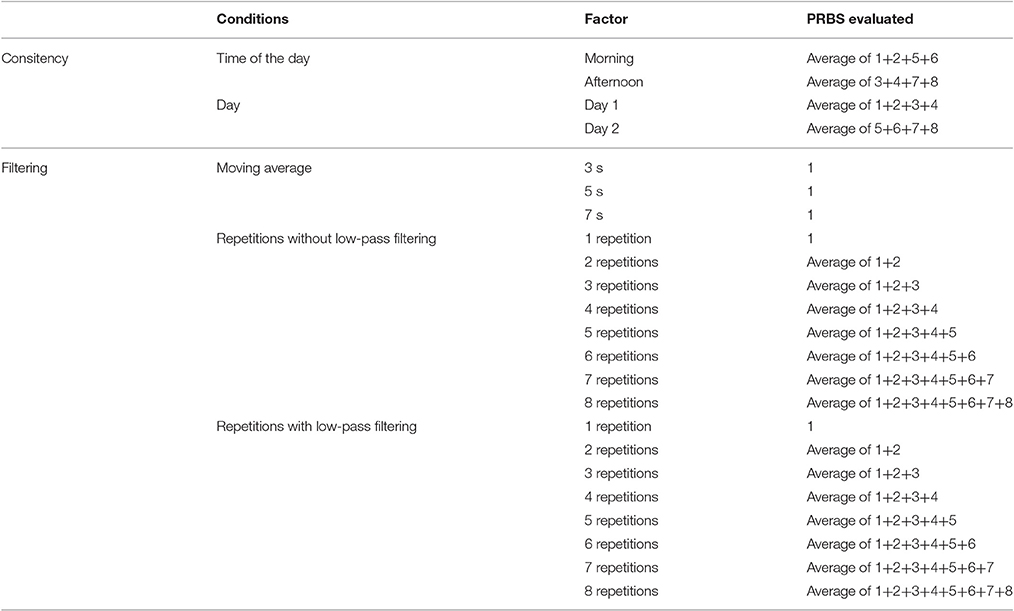
Table 1. Description of the pseudorandom binary sequence (PRBS) protocols (1–8) used to test the influence of some conditions and data pre-processing over the oxygen uptake dynamics.
Pseudorandom Binary Sequence Exercise Test (PRBS)
All exercise tests were performed on an electrically braked cycle ergometer controlled by an external, pre-programmed module (Lode Excalibur Sport, Lode B.V., Groningen, Netherlands). The PRBS protocol (Figure 1B) was generated by a digital shift register with an adder module feedback (Bennett et al., 1981; Hughson et al., 1990; Beltrame and Hughson, 2017b) (Figure 1A). The target Ẇ (reached after <1.5 s of transition following a modification of the ergometer controller) was 25 or 100 W, and the cadence was maintained at ≈ 1 Hz. As described in Figure 1, the PRBS protocol comprised 15 units (25 or 100 W) for 30 s (total of 450 s for each PRBS). According to previous studies (Beltrame and Hughson, 2017a,b), the highest Ẇ used in the current study (i.e., 100 W) is constrained to moderate intensity exercise thus avoiding the presence of system distortions that might influence the system temporal analysis.
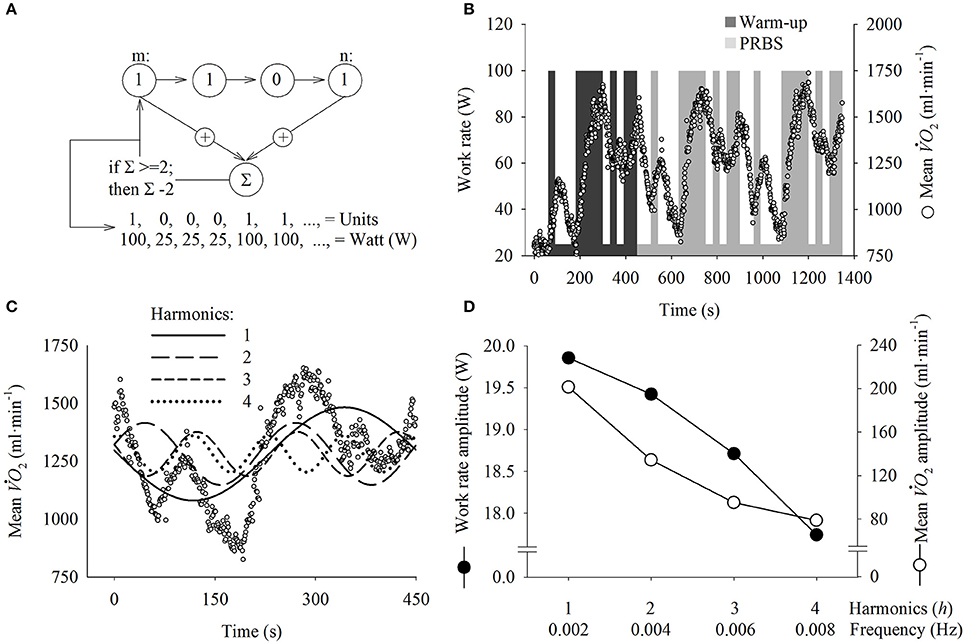
Figure 1. (A) Illustration of the 4-stage shift register used to generate the pseudorandom binary sequence protocol (PRBS). The module addition feedback (∑) sums the first and fourth stage values and tests the “if” statement. The value is then inserted into the first stage and the entire system shifts to the right, and the sequence repeats after 15 values. Each unit is maintained for 30s to create the PRBS protocol in the time-domain (B). The system input stimulates the oxygen uptake () response (−), here represented by the mean signal of all participants (n = 8) during the first visit. The data regarding the first PRBS sequence (warm-up) were excluded a priori. (C) To illustrate the frequency domain analysis, Fourier transformations were used to decompose the time-domain response of the second PRBS sequence into amplitudes of sinusoidal functions at specific frequencies (i.e., harmonics). The amplitudes of the system input (i.e., work rate in Watts) and output (i.e., ) at different frequencies are displayed in (D).
Data Acquisition and Analysis
The data were measured breath-by-breath by the Vmax system (CareFusion, San Diego, CA, USA) that estimates the air volume through a low resistance mass flow sensor (accuracy of >97%), the O2 pressure by an electro-chemical cell (accuracy of >99%), and the CO2 pressure by an infrared light with a thermopile (accuracy of >99%). The gas concentrations and air volume/flow were calibrated following manufacturer's specifications before each test. The raw breath-by-breath data were linearly interpolated second-by-second by the interpolation transform in SigmaPlot 12.5 software (Systat Software, San Jose, CA, USA)
When appropriate, different filtering techniques were applied over data. The moving average filtering level varied between different window sizes (3, 5, or 7 s) and the low-pass filter considered a cutoff frequency of 0.075 Hz following previous literature (Harper et al., 2006; Schlup et al., 2015). Filters were implemented in Origin 9.1 software (OriginLab Corp. Northampton, MA, USA). Afterwards, the data were time aligned and ensemble-averaged to obtain a single response per participant from different combinations of repetitions as described in Table 1.
Frequency Domain Analysis
The MNG was calculated based on the frequency-domain data transformation (Hughson et al., 1990). The datasets used for MNG calculations are described in Table 1; however, the last condition (low-pass filtering) was not tested due to the embedded filtering characteristics of the MNG estimation that has a cut-off frequency lower than 0.075 Hz (explained below).
The first step in the calculation of MNG required frequency domain analysis at each of the first four harmonics. Data from the exercise input (Ẇ) and output () were analyzed using a standard Discrete Fourier Transformation algorithm (Smith, 1999). The following sinusoidal function was solved for harmonics 1–4 as described previously (Hughson et al., 1990):
where t is the time of the PRBS, a0 is average response during the entire PRBS, f1 is the fundamental frequency calculated as the inverse of the protocol length of 450 s (i.e., 1/450 or 0.0022 Hz). As depicted in Figures 1C,D, the f1 can be defined as the lowest frequency evaluated and the subsequent frequencies were defined by the product between f1 and the harmonics (h). Harmonics are integer numbers that define how many complete sinusoidal cycles into which the time series signal was decomposed. The Ah and Bh are the cosine and sine amplitudes for a given harmonic h, respectively. From Ah and Bh, the sinusoidal amplitude (Amp) was computed for each h (Figure 1D) by:
The system gain was calculated at each h (gAmph) from the relationship for the individual input:output relationships at that harmonic by the ratio:
Isolating Temporal Dynamics from the Frequency Domain Responses
The MNG was calculated based on the normalization of individual harmonic gains. As illustrated by the arrow between Figures 2A,C, the system gains were normalized as a percentage of the gAmp at h1 (i.e., gAmp1) (Hoffmann et al., 1994; Beltrame and Hughson, 2017a,b). This normalization isolated the temporal dynamics of the system by removing the influences of the total gain (i.e., steady-state gain) across the harmonic amplitudes (Hoffmann et al., 1992). Therefore, based on a previous concept (Shmilovitz, 2005; Beltrame et al., 2017a; Beltrame and Hughson, 2017a,b), the new index of system dynamics called mean normalized system gain (MNG, expressed in % in Figure 2D) was obtained by the average of the normalized system gains (smaller arrow in Figure 2C) of the harmonics 2, 3, and 4 (h = 2, 3, and 4) following the equation:
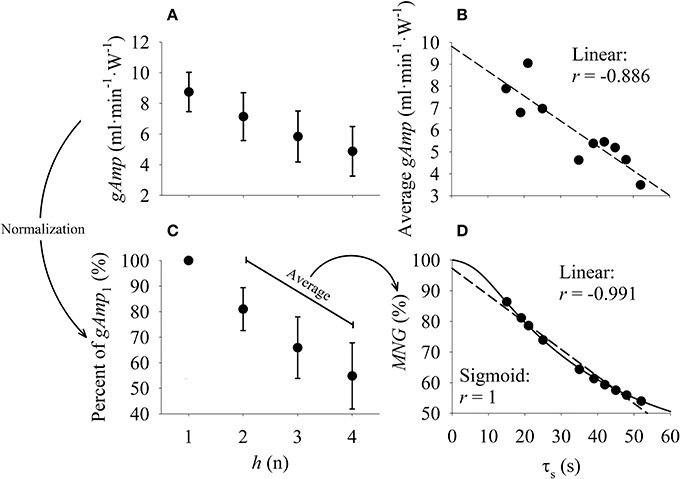
Figure 2. (A) Mean ± SD of 10 simulations of the system gain (gAmp) calculated in the frequency domain from data generated using 10 different values of system time constants (τs), amplitudes and baselines (see Table 2). (B) linear (– –) relationship between τs and the average absolute oxygen uptake gain at each tested harmonic (h) for each of the 10 simulations. (C) mean ± SD of data displayed in A normalized by the gAmp at h1. The mean normalized gain (MNG) was calculated as the mean of the gAmp between h2, h3, and h4 (please see text and Equation 4). (D) relationship between τs and MNG. This relationship was fitted by a linear (– –) and sigmoid (–) function. Notice in (D) that the normalization procedure isolated the relationship between amplitude and τs from other sources of system distortion such as system gain and baseline. The correlation coefficient “r” was used to indicate the degree of correlation between τs and MNG. Please see text for further details regarding the sigmoid function.
Time-Domain Analysis
The time-domain analysis of the data was conducted on a segment of the PRBS for comparison to the MNG obtained by frequency domain analysis. The data window length for time-domain analysis included the final 10s of a 90s period of 25 W followed by 120s at 100 W (starting at the 180th second of the PRBS protocol). This exercise window corresponded to the longest period without input variation, thus the best window for time-domain analysis within the PRBS protocol. The following equation was used to fit the data (Hughson and Morrissey, 1982; Whipp et al., 1982):
where t is time; a0 is the baseline at 25 W; a is the steady state amplitude at 100 W; τ is time constant (i.e., the “speed” of the system) and TD is the time delay of the exponential function onset. The initial data associated with the cardio-dynamic component (20 s) were excluded before data fitting. The mean response time (MRT) was calculated by adding t and TD (Macdonald et al., 1997). The quality of the fitting was assured by the analysis of squared error, coefficient of determination (r2), 95% confidence interval band (CI95) of the model (Fawkner et al., 2002; Keir et al., 2016) and the significance level (p-value) of the estimated parameters. The comparison between MNG and τ, both derived from measured data, has the purpose to experimentally support the expected correlation between both parameters (further demonstrated by computer simulations). It is worth to mention that this study was not designed to obtain τ under ideal condition since the dataset used for this purpose was, and must be for a fairer comparison between indexes, nested within the PRBS protocol. Therefore, the time domain approach was only used as a supplementary analysis to validate this new index (i.e., MNG) estimated from frequency domain response.
In silico Simulations: MNG vs. Time Constant
Simulations of the response stimulated by PRBS input were performed to determine the relationship between the time constant (for the simulations denoted τs) and MNG, derived from time- and frequency-domain analysis, respectively. Similarly to τs, MNG should extract information regarding the system adaptation speed from random exercise stimulus which ultimately is associated with aerobic fitness (Hagberg et al., 1980; Powers et al., 1985; Chilibeck et al., 1995; Hughson, 2009).
As previously described elsewhere (Hoffmann et al., 2013; Beltrame and Hughson, 2017a), an algorithm was created to simulate the response to PRBS considering the function described above in the Time-domain analysis section. This algorithm assumed a linear static and dynamic gain (Eßfeld et al., 1991; Hoffmann et al., 1992) with no time delay, as expected in muscular response (Hoffmann et al., 2013). Firstly, ten simulations were generated by arbitrarily selecting different combinations between a0, a1 and τs as described in Table 2. The average Amp gain between the analyzed frequencies and the MNG are also described in Table 2. For further discussion, the physiological range of τ and τs was defined as 10 < τ and τs < 100 s.
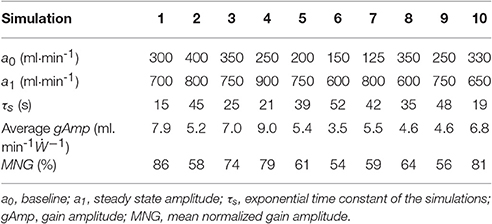
Table 2. Description of the parameter used for the computer simulations and the parameters obtained by frequency-domain analysis.
The system gains (Figure 2A) are dependent in the simulations on the values of a0 and a1 (amplitude components) as well as τs (speed component). Since the extraction of the system temporal characteristics (such as τs) is the goal of our index, a0 and a1 can be considered as confounding factors. Thus, as shown in Figure 2B, the simple average of the absolute gains across the tested frequencies was not able to perfectly predict τs; however, the normalization method used to obtain the MNG was able to better isolate τs from the different system gains and baselines (Figure 2D). In addition to the simulations that used a physiological range of the parameters, more simulations were performed to further investigate the expected behavior of the relationship between MNG and τs. These simulations (n = 10) used a constant a0 and a1 but varied τs to extreme values (0.001, 0.1, 1, 5, 15, 35, 80, 200, 500, and 1500 s). Different combinations of harmonics (i.e., h′s) to calculate MNG (derived from equation 4) were also tested. Specifically, the following combinations between h were tested for the MNG calculation: 2 ≤ h ≤ 3, 2 ≤ h ≤ 4, 2 ≤ h ≤ 5, and 2 ≤ h ≤ 10. The relationship between MNG and τs (Figures 2D, 3) was described by a sigmoid function. The x-axis scale in Figure 3 was converted to log10 for a better visualization of this relationship.
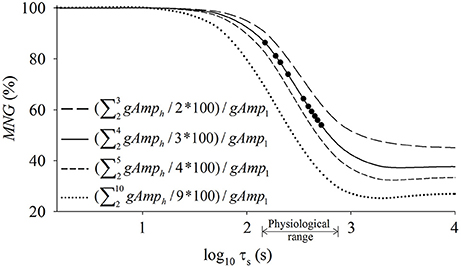
Figure 3. Computer simulations were performed to generate different oxygen uptake () responses considering different values of time constant (τs) that defines the speed of the adjustment to random exercise. The data were transformed to frequency domain and the mean normalized gain amplitude (MNG) was obtained considering the normalized system gain obtained from different frequency ranges. The equations describe how the MNG was obtained from the data. The x-axis scale was converted to log10 for a better visualization of the sigmoidal characteristics of the relationship between MNG and τs. The symbols “•” represent the simulated data from Figure 2D. Please see Equation (4) and text for further details regarding the equation parameters and procedures. Notice that the linear portion of the sigmoid function is always located at the physiological portion of tau values (i.e., from 10 to 100 s).
If more normalized gains from the simulated linear systems are considered into MNG calculation (equations in Figure 3), the sigmoid is shifted to left and the plateau for longer τs became smaller. However, the physiological range (arrow in Figure 3) of τs was always located at the approximately-linear portion of the sigmoid, independently of the number of harmonics used to calculate MNG. The improvements (measured by the r-value) from the sigmoidal to the linear fitting was minimal (or 0.9% as displayed in Figure 2D). Therefore, considering the model degree of freedom, the physiological range in τ, and the error associated with the τ estimation from real data, the relationship between MNG and τ was simplified to a linear relationship (– –, in Figures 2B,D). The system analysis of the current study was limited to the fourth harmonic (Figure 2A, h = 4 or 0.008 Hz) because the data, and presumably the aerobic system response, can be analyzed as a first order linear system (Hoffmann et al., 1992). It is important to adhere to the linearity principle to avoid misinterpretation about the dynamics that might not be driven directly by work rate effect on the metabolic response but by circulatory distortions at frequencies higher than ≈0.01 Hz (Hoffmann et al., 1992). Kinetics analyses and data simulations were performed by a certified (#100-314-4110) LabVIEW associated developer (National Instruments, Austin, TX, USA).
Statistical Analysis
According to Shapiro-Wilk test, most of the data were normally distributed. The MNG, τ and MRT were compared between different conditions (time of day, or different days) by paired t-test. One way repeated measures ANOVA was used to test the impact of the moving average filtering level on MNG by comparing different average window sizes (3, 5, or 7 s) applied over the first PRBS protocol with the signal from this same protocol without filter. The MNG was compared between different exercise repetitions (1–8) by one way repeated measures ANOVA. Statistical differences in τ and MRT obtained from different exercise repetitions (1–8) with or without low-pass filtering were assessed by two way repeated measures ANOVA. Student-Newman-Keuls method was selected for post-hoc analysis. When appropriate, sample size was calculated using Student t-test or paired t-test as reference test and considering the SD of the MNG or τ, both estimated from eight exercise repetitions without filtering, with the power set at 0.8. The linear correlation was measured by Pearson product-moment correlation coefficient (r) and coefficient of determination (r2). The agreement level was assessed by Bland-Altman plot and CI95 (Altman and Bland, 1983). The CI95 of τ and MNG was obtained as 1.96*SD of the group response and, for the sake of comparison between these parameters, the CI95 was reported as percentage of the group mean. For all statistical tests, the statistical significance (p) was set at < 0.05. Statistical analysis was conducted in SigmaPlot 12.5 software (Systat Software, San Jose, CA, USA).
Results
MNG vs. τ
The parameters from time-domain analysis (a0, a1, τ, and TD) and the MNG obtained by frequency-domain analysis based on different exercise repetition combinations and frequency filtering levels are reported in Table 3. The parameter estimates of τ and MRT were not statistically (p > 0.05) different between different exercise repetitions, nor were they different with or without low-pass filtering.
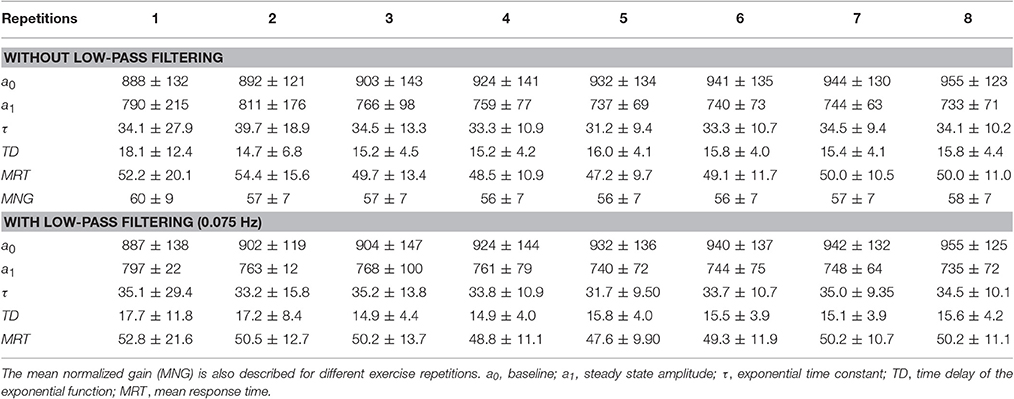
Table 3. Parameter obtained by time-domain oxygen uptake analysis considering different combinations of exercise repetitions (1–8) with our without low-pass filtering (0.075 Hz).
Figure 4 shows the correlation between τ and MNG obtained by time- and frequency-domain analysis, respectively. Both parameters were obtained based on eight-repetition dataset and τ was also obtained from low-pass filtered data. For visual comparison, the simulated data displayed in Figure 2D are also plotted in Figure 4. The MNG of the experimental data were consistently less for all participants than the values obtained with simulated data for any value of τ.
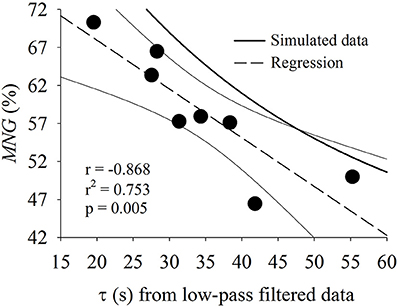
Figure 4. Relationship between time constant (τ) calculated from low-pass filtered oxygen uptake data and mean normalized gain (MNG). Both indexes were obtained from eight repetitions for all participants (n = 8) of the pseudorandom binary sequence test. The individual values (black circles), the regression line (dashed) and 95% CI (solid thin lines) are shown in comparison to the simulated data (solid thick line for MNG vs. τs as in Figures 2C).
Influence of Time of Day and between Days
The τ, MRT, and MNG were not statistically different when compared across time of day (p > 0.05) and between days (p > 0.05). The relationship and the agreement level of the MNG (Figure 5) and τ (Figure 6) obtained during the morning and afternoon (Figures 6A,C) and in different days (Figures 6B,D). The MNG was strongly correlated between the time of day (morning vs. afternoon) and between days (day 1 vs. day 2). The bias of the MNG calculation represented 4.92 and 5.57% of the total MNG variation during the different time of the day and between days, respectively. The CI95 were equivalent to 18.21 and 13.78% of the total MNG variation of the sample for the different time of the day and between days, respectively. The τ was not correlated between the time of day (morning vs. afternoon) possibly due to the outlier identified in Figure 6A by the arrow. However, τ was strongly correlated between days (day 1 vs. day 2). The bias of the τ calculation represented 9.11 and 5.58% of the total τ variation during the different time of the day and between days, respectively. The CI95 were equivalent to 95.28 and 47.28% of the total τ variation of the sample for the different time of the day and between days, respectively.
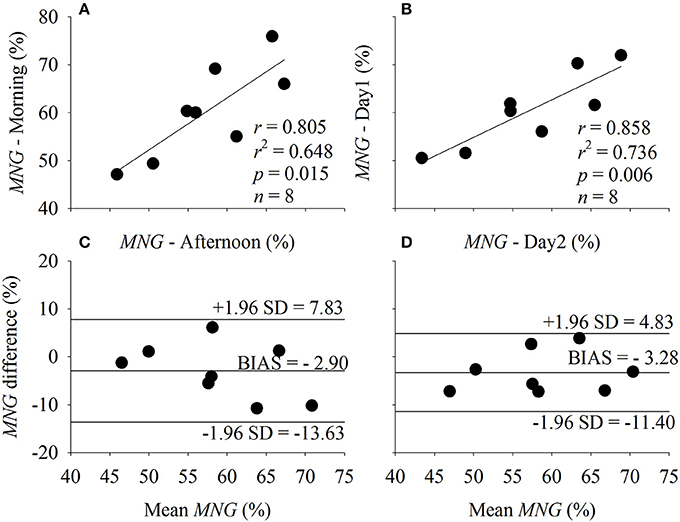
Figure 5. Correlation between the mean normalized gain amplitude (MNG) estimated under the influence of different time of the day (A, Morning vs. Afternoon) and different day of testing (B, Day 1 vs. Day 2). The agreement level between the factors plotted in (A,B) are displayed in (C,D), respectively. r, Pearson's correlation level; p, statistical significance level; and n, sample size.
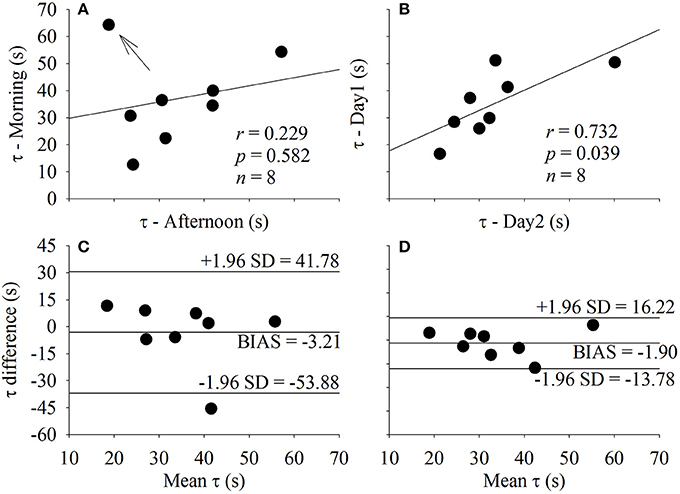
Figure 6. Correlation between the time constant (τ) estimated under the influence of different time of the day (A, Morning vs. Afternoon) and different day of testing (B, Day 1 vs. Day 2). The agreement level between the factors plotted in (A,B) are displayed in (C,D), respectively. The arrow indicates an outlier. r, Pearson's correlation level; p, statistical significance level; n, sample size.
Influence of the Averaging Level and Number of Repetitions
The different moving average filtering levels (3, 5, or 7 s) have not impacted the MNG estimation during the first PRBS protocol. The correlation coefficient r was 0.99 for all levels in comparison to the signal without moving average filtering. In addition, the bias and the CI95 between all filtering levels and the signal without filtering was minimal (< ≈1%).
Figure 7 illustrates the sample size needed to find statistical significance for a given effect size (changes in MNG or τ) by Student t-test (Figures 7A,B for MNG and τ, respectively) or Paired t-test (Figures 7C,D for MNG and τ, respectively) considering different number of repetitions averaged together before data analysis (time or frequency-domain analysis). The relationship between sample size and the effect size suggested an exponential-decay-like function. The sample size of τ was more dependent on the number of repetitions in comparison to MNG in both tests (Student and Paired t-test).
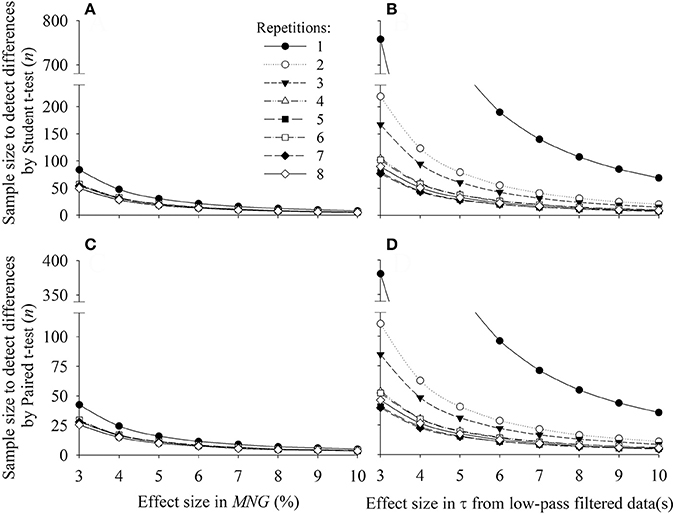
Figure 7. Relationship between effect size of the mean normalized gain amplitude (MNG) or time constant from low-pass filtered data (τ) with the sample size needed to find statistical significance by student t-test (A,B) or paired t-test (C,D) considering different number of exercise repetitions (symbols). The desired power and the significance level considered for the sample size calculations were 0.8 and 0.05, respectively.
The repeated measures ANOVA showed that the MNG, as well as τ, were not statistically different (p > 0.05) between different exercise repetitions. However, as depicted in Figure 8, the CI95 normalized by the group mean response of τ and MNG differed when different numbers of PRBS were ensemble-averaged before data analysis. As expected considering the short data window and model degree of freedom, the τ CI95 was extremely high when only one exercise repetition was considered for data modeling. After that, the τ CI95 stabilized after four exercise repetitions at ≈70% for both, with or without low-pass filter. If we consider that the aerobic system temporal dynamics were unchanged across different exercise repetitions, the observed τ CI95 of 70% in filtered data can be interpreted as an intrinsic variability originating from time-domain data modeling and from variable aerobic fitness of the participants. On the other hand, the MNG CI95 seemed to be independent of the number of exercise repetitions and it was stable at ≈30% which indicated a lower method-originated variability, isolating variations of aerobic fitness from the calculation distortions. Therefore, the actual variability of the aerobic system temporal dynamics, understood as aerobic fitness, seems to be approximately 40% around the mean.
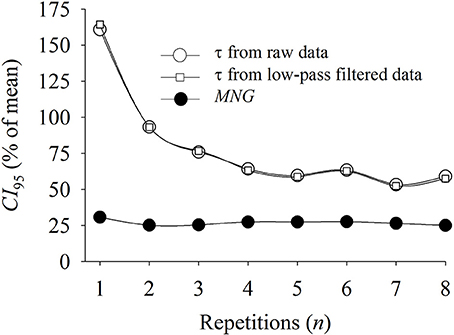
Figure 8. Relationship between the confidence interval (CI95, reported as percentage of the mean) of the time constant (τ) and mean normalized gain (MNG) obtained from different numbers of exercice repetitions. The τ was obtained from raw and filtered (0.075 Hz) oxygen uptake data. The τ CI95 stabilized at ≈70% after four exercise repetitions while the MNG CI95 was constant at ≈30% across all exercise repetitions.
Discussion
In agreement with our initial hypothesis, the calculation of MNG was able to characterize the temporal dynamics of to random exercise input being strongly correlated with the time-domain indicator, τ, obtained in the same persons. The MNG eliminated the expected differences in static gain between individuals by expressing the dynamic response as a percentage of the fundamental harmonic value. The comparison of MNG against the time-domain kinetics analysis was shown to be independent of the period of the day, the day of the test, the filtering technique used and the number of exercise repetitions ensemble-averaged before data analysis. The detection of differences in MNG was independent of the number of exercise repetitions for differences higher than ≈8% which correspond to a τ variation of ≈15 s. Further, these data are important for the experimental design of further studies by informing the number of repetitions necessary according to an expected effect size (Figure 7). In addition, as reported in Figure 8, MNG seemed to be, in comparison with τ, ≈50% less susceptible to noise than time-domain analysis thus isolating better the temporal dynamics of the aerobic response to changes in energy demand.
The breath-by-breath fluctuation (Lamarra et al., 1987) during exercise transitions adds uncertainty to time-domain parameter prediction, mainly from a single test dataset. The confidence interval of the estimated τ, and therefore the “sensitivity” to identify aerobic fitness differences, depends on the signal-to-noise ratio (Lamarra et al., 1987; Keir et al., 2014b), the model complexity (i.e., the degree of freedom) (Motulsky and Ransnas, 1987) and the selected data window (Bell et al., 2001; Murias et al., 2011). To increase signal-to-noise ratio, studies commonly repeat similar tests multiple times within the same session (Ozyener et al., 2001; Christensen et al., 2016) or on different days (Whipp et al., 1982; Keir et al., 2014a) and average repetition-like transitions before time-domain data modeling.
The frequency-domain analysis has some advantages over the time-domain approach. Firstly, no explicit data modeling with a degree of arbitrariness is necessary (Eßfeld et al., 1987) since the time series can be decomposed, and therefore rebuilt from the infinite sum of its harmonic components (Hughson et al., 1990). Second, the random noise associated with measured at the mouth (Lamarra et al., 1987) is filtered when transferred into frequency space, diminishing the impact of the inter-breath oscillations over the dynamics characterization.
The early studies from Eßfeld et al. (1991) and Hoffmann et al. (1992) were the first to normalize the system gain amplitudes by the amplitude at the fundamental harmonic (i.e., gAmp1 in Equation 4). They successfully showed that a faster kinetics maintained a higher normalized gain across the frequency spectrum. However, since the focus of their experiments was to investigate possible aerobic system controllers, no further comparisons were carried out to explore the applicability of this normalization for the temporal dynamics assessment. Other studies used the absolute system gain to infer about dynamics (Eßfeld et al., 1987; Hughson et al., 1990, 1991). In fact, the use of absolute gains may be sufficient for intra-subject comparisons since the system static gain seems to remain constant as the aerobic system “speeds up” after training (Christensen et al., 2016). However, for the comparison between subjects by an absolute index such as τ, the gain must be normalized.
We demonstrated by computer simulations (Table 2, Figure 2) that MNG was able to characterize the temporal characteristics of the aerobic system by comparing MNG with τs. The MNG refined the ability of the Fourier transformation to separate the system dynamic gain from the static gain, isolating therefore the rate at which the aerobic system supplies the energy demand (i.e., power) from the capacity of the aerobic system to supply the demand at steady state. The latter is susceptible to inter-individual variability which confounds the interpretation of the temporal dynamics based on the system absolute gains (as demonstrated in Figure 2B).
In the experimental data (Figure 4), we demonstrated that the MNG was significantly correlated to τ (used as reference). The τ calculated from eight repetitions and low-pass filter still has an intrinsic non-physiological variability that could be associated with the low signal-to-noise ratio as a consequence of noise, short data window and/or elevated modeling degrees of freedom. The CI95 of the τ estimated from eight repetitions and low-pass filtered (0.075 Hz) data between all participants (n = 8) was 19.8 s which represented 57% of the average τ-value. In contrast, the MNG presented a lower variability in comparison to τ possibly due to the inherent noise reduction and the lower degrees of freedom of the proposed method. Consequently, only 75% of the MNG variation could explain the variations in τ, both calculated based on eight exercise repetitions (Figure 4). However, we demonstrated (Figure 8) that ≈30% of the τ variability (from total of ≈60%) seems to be a consequence of data modeling by comparing MNG and CI95. This might be occurring because τ, as an explicit parameter, has an intrinsic degree of freedom originating from data modeling (Motulsky and Ransnas, 1987). Therefore, based on Figure 8, the MNG seemed to “isolate” aerobic system temporal dynamics from noise better than τ obtained from time-domain analysis, even after eight repetitions and filtering. In addition, in agreement with previous research (Keir et al., 2014b), the CI95 of τ was more dependent on the number of exercise repetitions in comparison to MNG where the CI95 was independent of exercise repetitions.
The biological significance of τ and MNG was also demonstrated in Figures 5, 6 by estimating these indexes at different conditions described in Table 1. The temporal dynamics of the response, and presumably the aerobic fitness, should not suffer major changes between periods of day or the day of testing. However, MNG (Figure 5) seems to have lower variability associated to the method of choice in comparison to τ (Figure 6) which is in accordance to Figures 7, 8. In addition, the participant identified as an outlier (arrow in Figure 6A) was not apart from the group response in Figure 5A (MNG). Therefore, the unexpected behavior of the dynamics during the exercise transition used for τ estimation was not “transferred” to MNG because the source of this distortion was not periodic.
As demonstrated in Figure 4, the relationship between τ and MNG was systematically below the simulated data (MNG vs. τs, Figures 4, 2C). There are two possible explanations for this. Firstly, following Hoffmann et al. (2013) and as expected to occur in the muscle, the simulations were generated based on a non-delayed exponential response (single time constant τs, no TD). However, the response at the mouth is classically described as a delayed exponential response (single time constant τ with a TD). The addition of the TD term to the fitting model is a mathematical way to account for the “latency” period when the muscle responses have not started to be expressed at the mouth level due to circulatory transit time. Like the phase shift obtained from frequency-domain analysis (Eßfeld et al., 1987), the parameter TD has an elevated variability between subjects without main physiological relevance. Therefore, comparing the exponential characteristics (i.e., τ) of the response at the mouth to the simulated data τs appears to show an incorrect gain amplitude generated at the muscle in higher frequencies effectively “slowing down” the response in frequency domain (i.e., lower MNG-values). A possible way to account for this issue is to consider the sum of τ and TD, or the mean response time (MRT), as the “effective” muscular time constant measured at the mouth level (Linnarsson, 1974; Whipp and Ward, 1990). In comparison to Figure 4 and as depicted in Figure 9, the addition of TD term brings the relationship between MRT and MNG in line with the simulated data. Despite the apparent differences in r and p-values for the MNG vs. MRT compared to the MNG vs. τ (r = −0.802, p = 0.016 and r = −0.855, p = 0.006 respectively for 8 repetitions), the CI95 and the squared error were not statistically different (p > 0.05 by paired t-test) considering the individual responses. Therefore, the inclusion of the TD did not alter the relationship between MNG and the time-domain dynamics indicators (τ or MRT). It is known that TD does not carry biological information (Eßfeld et al., 1987; Hoffmann et al., 2013) and its inclusion is commonly related to data modeling strategy (Whipp and Ward, 1990).
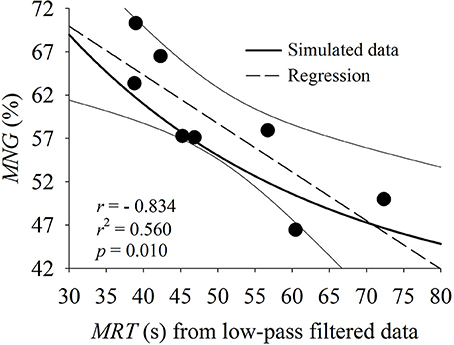
Figure 9. Relationship between mean response time (MRT) calculated from filtered oxygen uptake data and mean normalized gain (MNG). Both indexes were obtained from eight repetitions for all participants (n = 8) of the pseudorandom binary sequence test. As the individual values (black circles), the regression line (dashed) and 95% CI (solid thin lines) are shown in comparison to the simulated data (solid thick line for MNG vs. τs as in Figure 2C).
An alternative explanation of why the MNG based on the experimental data is below the simulated data (Figure 4) is based on the system linearity. The measured at the mouth presented a certain degree of energy dispersion across the spectrum due to circulatory distortions and/or all the assumptions that are necessary to obtain an estimate of from ventilatory and gas concentration signals. In contrast, the data simulation was based on a purely linear system that did not present any source of distortion beyond the one related to the exercise stimulus. In the simulations, all energy applied to the system was perfectly converted into the same-order output response by the superposition law, maintaining a higher gain across the frequencies. The possibility exists that even in the range of input stimulation frequencies assumed to result in linear output () (Hoffmann et al., 1992) that non-linearities exist effectively lowering the system response at the higher frequencies. It was previously speculated (Hughson et al., 1990; Hoffmann et al., 1992) that distortions of the circulatory system which includes O2 stores oscillations, variable muscle-to-lungs transit time and blood venous volume (Hoffmann et al., 2013) might influence the expression of the dynamics at the mouth level at high frequencies.
Another advantage of MNG over time-domain-derived temporal indexes is that it does not require an arbitrary decision for data modeling regarding the length of the cardio-dynamic phase that is variable between participants (Murias et al., 2011). The MNG is estimated from periods longer than 112 s thus this index does not reflect the cardio-dynamic components during exercise transitions.
Limitations
The intrinsic degree of uncertainty associated with τ estimated from the exponential modeling precludes the use of τ as a “gold standard” method to validate the use of MNG to assess the system temporal dynamics. The CI95 of the relationship between τ (and MRT) with MNG might be influenced by the elevated CI95 of τ estimation (and TD for MRT). Therefore, there is an expected source of error also in the reference method (time-domain) which complicates the validation method. Our data showed that a faster response will be translated to a higher MNG or a lower τ and MRT; however, the ability of the MNG to extract this information from data seemed optimized and more sensitive to detect differences in the system temporal dynamics due to its inherent filtering characteristics and the lower degrees of freedom.
As a Fourier transformation criterion, the proposed method assumes a symmetrical dynamic between the exercise onset and recovery transitions. However, the signal may be composed of asymmetries between these two phases during exercise intensities higher than moderate (Ozyener et al., 2001; Markovitz et al., 2004). The highest intensity used in the current study (100 watts) was restricted to moderate intensity (Bennett et al., 1981; Eßfeld et al., 1987; Hughson et al., 1988); therefore, the MNG can be compared to the τ obtained from the response during the onset exercise transition.
Although the frequency range selected in the current study limits the response to a range where the system linearity is reportedly preserved (Hoffmann et al., 1992) the MNG might still be susceptible to system non-linearities originating from circulatory distortions or some sort of periodic noise can be present at higher frequencies. Further studies might explore the application of specific filtering techniques (Eßfeld et al., 1987; Hoffmann et al., 1992) to remove noises/responses uncorrelated to exercise in order to increase even more the precision of the proposed index to characterize the temporal dynamics of the response. However, consistent with the purpose of this index, we successfully showed that a faster aerobic response can be characterized by a higher MNG since that the majority of the evaluated harmonics were probably linear. These results should also be verified across a wider range of participants with differing levels of physical fitness and health status.
Conclusion
Characterization of physical fitness has classically been conducted by measurement of maximal (Astrand and Saltin, 1961; Drake et al., 1968). Varying levels of physical fitness and the effects of training programs are also associated with differing kinetics of adaptation of , expressed by τ, to the challenge of a step increase in Ẇ (Phillips et al., 1995). The temporal characteristics of the oxygen uptake () dynamic during moderate exercise have previously been related to maximal aerobic power (Beltrame and Hughson, 2017b) and a faster response was associated with a better aerobic fitness (Powers et al., 1985; Norris and Petersen, 1998), functional mobility (Alexander et al., 2003), and disease prognosis (Borghi-Silva et al., 2012). This study, beyond demonstrating how to compute, validated a new method to assess dynamics in random exercises more typical of daily life.
The MNG can be used to identify changes in the temporal aerobic system dynamics. The applicability of our findings may extend beyond controlled exercise protocols as shown with simulated activities of daily living (Beltrame et al., 2017a) and in freely moving daily life (Beltrame et al., 2017b). Indeed, MNG has the potential importance to rehabilitation programs, exercise prescription and fitness evaluation where the temporal dynamics of the aerobic response might be related to aerobic power (Beltrame and Hughson, 2017b). The inherent filtering characteristics, the need for no model assumption and the low variability between days and time of the day seems to make MNG attractive for the evaluation of the aerobic system temporal dynamics. Additionally, because MNG is expressed as a percent of the fundamental harmonic, it can be applied to comparisons of system dynamics across the variables contributing to the delivery and utilization of oxygen independent of their formal units. In conclusion, the present study successfully validated the use of the MNG as a tool for aerobic system analysis based on random exercise stimulus.
Author Contributions
TB and RH conceived and designed research, performed experiments, analyzed data, interpreted results of experiments, prepared figures, drafted manuscript, edited and revised manuscript, and approved final version of manuscript.
Funding
This study was funded by the Natural Sciences and Engineering Research Council of Canada held by RH (RGPIN-6473) and by the Conselho Nacional de Desenvolvimento Científico e Tecnológico held by TB (202398/2011-0).
Conflict of Interest Statement
The authors declare that the research was conducted in the absence of any commercial or financial relationships that could be construed as a potential conflict of interest.
Abbreviations
a0, Baseline; a1, Steady state amplitude; f1, Fundamental frequency; gAmp, System gain; h, Harmonic number; MNG, Mean normalized gain; MRT, Mean response time; PRBS, Pseudorandom binary sequence; τ, Time constant; TD, Time delay of the exponential function; τs, Time constant of simulations; , Oxygen uptake; Ẇ, Work rate.
References
Alexander, N. B., Dengel, D. R., Olson, R. J., and Krajewski, K. M. (2003). Oxygen-uptake (˙VO2) kinetics and functional mobility performance in impaired older adults. J. Gerontol. A Biol. Sci. Med. Sci. 58, 734–739. doi: 10.1093/gerona/58.8.M734
Altman, D. G., and Bland, J. M. (1983). Measurement in medicine : the analysis of method comparison studies. Statistician 32, 307–317. doi: 10.2307/2987937
Astrand, P. O., and Saltin, B. (1961). Maximal oxygen uptake and heart rate in various types of muscular activity. J Appl Physiol. 16, 977–981.
Bell, C., Paterson, D. H., Kowalchuk, J. M., Padilla, J., and Cunningham, D. A. (2001). A comparison of modelling techniques used to characterise oxygen uptake kinetics during the on-transient of exercise. Exp. Physiol. 86, 667–676. doi: 10.1113/eph8602150
Beltrame, T., Amelard, R., Villar, R., Shafiee, M. J., Wong, A., and Hughson, R. L. (2016). Estimating oxygen uptake and energy expenditure during treadmill walking by neural network analysis of easy-to-obtain inputs. J. Appl. Physiol. 121, 1226–1233. doi: 10.1152/japplphysiol.00600.2016
Beltrame, T., Amelard, R., Wong, A., and Hughson, R. L. (2017a). Prediction of oxygen uptake dynamics by machine learning analysis of wearable sensors during activities of daily living. Sci. Rep. 7:45738. doi: 10.1152/japplphysiol.00299.2017
Beltrame, T., Amelard, R., Wong, A., and Hughson, R. L. (2017b). Extracting aerobic system dynamics during unsupervised activities of daily living using wearable sensor machine learning models. J. Appl. Physiol. 8:jap.00299.2017. doi: 10.1038/srep45738
Beltrame, T., and Hughson, R. L. (2017a). Linear and nonlinear contributions to oxygen transport and utilization during moderate random exercise in humans. Exp. Physiol. 102, 563–577. doi: 10.1113/EP086145
Beltrame, T., and Hughson, R. L. (2017b). Aerobic system analysis based on oxygen uptake and hip acceleration during random over-ground walking activities. Am. J. Physiol. Regul. Integr. Comp. Physiol. 312, R93–R100. doi: 10.1113/EP086145
Bennett, F. M., Reischl, P., Grodins, F. S., Yamashiro, S. M., and Fordyce, W. E. (1981). Dynamics of ventilatory response to exercise in humans. J. Appl. Physiol. 51, 194–203.
Borghi-Silva, A., Beltrame, T., Reis, M. S., Sampaio, L. M. M., Catai, A. M., Arena, R., et al. (2012). Relationship between oxygen consumption kinetics and BODE index in COPD patients. Int. J. Obstruct. Pulmon. Dis. 7, 711–718. doi: 10.2147/COPD.S35637
Chilibeck, P. D., Paterson, D. H., Petrella, R. J., and Cunningham, D. A. (1995). The influence of age and cardiorespiratory fitness on kinetics of oxygen uptake. Can. J. Appl. Physiol. 21, 185–196. doi: 10.1139/h96-015
Christensen, P. M., Jacobs, R. A., Bonne, T., Fluck, D., Bangsbo, J., and Lundby, C. (2016). A short period of high-intensity interval training improves skeletal muscle mitochondrial function and pulmonary oxygen uptake kinetics. J. Appl. Physiol. 120, 1319–1327. doi: 10.1152/japplphysiol.00115.2015
Drake, V., Jones, G., Brown, J. R., and Shephard, R. J. (1968). Fitness performance tests and their relationship to the maximal oxygen uptake of adults. Can. Med. Assoc. J. 99, 844–848.
Edwards, A. M., Challis, N V, Chapman, J. H., Claxton, D. B., and Fysh, M. L. (2001). The test-retest reliability of gas exchange kinetics in humans using a pseudo random binary sequence exercise test. Eur. J. Appl. Physiol. 85, 333–338. doi: 10.1007/s004210100441
Edwards, A. M., Claxton, D. B., and Fysh, M. L. (2003). A comparison of two time-domain analysis procedures in the determination of kinetics by pseudorandom binary sequence exercise testing. Eur. J. Appl. Physiol. 88, 411–416. doi: 10.1007/s00421-002-0725-y
Eßfeld, D., Hoffmann, U., and Stegemann, J. (1987). kinetics in subjects differing in aerobic capacity: investigation by spectral analysis. Eur. J. Appl. Physiol. Occup. Physiol. 56, 508–515. doi: 10.1007/BF00635362
Eßfeld, D., Hoffmann, U., and Stegemann, J. (1991). A model for studying the distortion of muscle oxygen uptake patterns by circulation parameters. Eur. J. Appl. Physiol. Occup. Physiol. 62, 83–90. doi: 10.1007/BF00626761
Fawkner, S. G., Armstrong, N., Potter, C. R., and Welsman, J. R. (2002). Oxygen uptake kinetics in children and adults after the onset of moderate-intensity exercise. J. Sports Sci. 20, 319–326. doi: 10.1080/026404102753576099
Hagberg, J. M., Hickson, R. C., Ehsani, A. A., and Holloszy, J. O. (1980). Faster adjustment to and recovery from submaximal exercise in the trained state. J. Appl. Physiol. 48, 218–224.
Harper, A. J., Ferreira, L. F., Lutjemeier, B. J., Townsend, D. K., and Barstow, T. J. (2006). Human femoral artery and estimated muscle capillary blood flow kinetics following the onset of exercise. Exp. Physiol. 91, 661–671. doi: 10.1113/expphysiol.2005.032904
Hoffmann, U., Drescher, U., Benson, A. P., Rossiter, H. B., and Essfeld, D. (2013). Skeletal muscle kinetics from cardio-pulmonary measurements: Assessing distortions through O2 transport by means of stochastic work-rate signals and circulatory modelling. Eur. J. Appl. Physiol. 113, 1745–1754. doi: 10.1007/s00421-013-2598-7
Hoffmann, U., Eßfeld, D., Leyk, D., Wunderlich, H. G., and Stegemann, J. (1994). Prediction of individual oxygen uptake on-step transients from frequency responses. Eur. J. Appl. Physiol. Occup. Physiol. 69, 93–97. doi: 10.1007/BF00609399
Hoffmann, U., Eßfeld, D., Wunderlich, H. G., and Stegemann, J. (1992). Dynamic linearity of VO2 responses during aerobic exercise. Eur. J. Appl. Physiol. Occup. Physiol. 64, 139–144. doi: 10.1007/BF00717951
Hughson, R. L. (2009). Oxygen uptake kinetics: historical perspective and future directions. Appl. Physiol. Nutr. Metab. 34, 840–850. doi: 10.1139/H09-088
Hughson, R. L., and Morrissey, M. (1982). Delayed kinetics of respiratory gas exchange in the transition from prior exercise. J. Appl. Physiol. 52, 921–929.
Hughson, R. L., Sherrill, D. L., and Swanson, G. D. (1988). Kinetics of VO2 with impulse and step exercise in humans. J. Appl. Physiol. 64, 451–459.
Hughson, R. L., Winter, D. A., Patla, A. E., Swanson, G. D., and Cuervo, L. A. (1990). Investigation of VO2 kinetics in humans with pseudorandom binary sequence work rate change. J. Appl. Physiol. 68, 796–801.
Hughson, R. L., Xing, H. C., Borkhoff, C., and Butler, G. C. (1991). Kinetics of ventilation and gas exchange during supine and upright cycle exercise. Eur. J. Appl. Physiol. Occup. Physiol. 63, 300–307. doi: 10.1007/BF00233866
Keir, D. A., Murias, J. M., Paterson, D. H., and Kowalchuk, J. M. (2014a). Breath-by-breath pulmonary O2 uptake kinetics: effect of data processing on confidence in estimating model parameters. Exp. Physiol. 99, 1511–1522. doi: 10.1113/expphysiol.2014.080812
Keir, D. A., Nederveen, J. P., Paterson, D. H., and Kowalchuk, J. M. (2014b). Pulmonary O2 uptake kinetics during moderate-intensity exercise transitions initiated from low versus elevated metabolic rates: insights from manipulations in cadence. Eur. J. Appl. Physiol. 114, 2655–2665. doi: 10.1007/s00421-014-2984-9
Keir, D. A., Robertson, T. C., Benson, A. P., Rossiter, H. B., and Kowalchuk, J. M. (2016). The influence of metabolic and circulatory heterogeneity on the expression of pulmonary VO2 kinetics in humans. Exp. Physiol. 101, 176–192. doi: 10.1113/EP085338
Koschate, J., Drescher, U., Thieschafer, L., Heine, O., Baum, K., and Hoffmann, U. (2016). Cardiorespiratory kinetics determined by pseudo-random binary sequences - comparisons between walking and cycling. Int. J. Sports Med. 37, 1110–1116. doi: 10.1055/s-0042-114702
Lamarra, N., Whipp, B. J., Ward, S. A., and Wasserman, K. (1987). Effect of interbreath fluctuations on characterizing exercise gas exchange kinetics. J. Appl. Physiol. 62, 2003–2012.
Linnarsson, D. (1974). Dynamics of pulmonary gas exchange and heart rate changes at start and end of exercise. Acta Physiol. Scand. Suppl. 415, 1–68.
Macdonald, M., Pedersen, P. K., and Hughson, R. L. (1997). Acceleration of VO2 kinetics in heavy submaximal exercise by hyperoxia and prior high-intensity exercise. J. Appl. Physiol. 83, 1318–1325.
Markovitz, G. H., Sayre, J. W., Storer, T. W., and Cooper, C. B. (2004). On issues of confidence in determining the time constant for oxygen uptake kinetics. Br. J. Sports Med. 38, 553–560. doi: 10.1136/bjsm.2003.004721
Motulsky, H. J., and Ransnas, L. A. (1987). Fitting curves to data using nonlinear regression: a practical and nonmathematical review. FASEB J. 1, 365–374.
Murias, J. M., Spencer, M. D., Kowalchuk, J. M., and Paterson, D. H. (2011). Influence of phase I duration on phase II VO2 kinetics parameter estimates in older and young adults. Am. J. Physiol. Regul. Integr. Comp. Physiol. 301, 218–224. doi: 10.1152/ajpregu.00060.2011
Norris, S. R., and Petersen, S. R. (1998). Effects of endurance training on transient oxygen uptake responses in cyclists. J. Sports Sci. 16, 733–738. doi: 10.1080/026404198366362
Ozyener, F., Rossiter, H. B., Ward, S. A., and Whipp, B. J. (2001). Influence of exercise intensity on the on- and off-transient kinetics of pulmonary oxygen uptake in humans. J. Physiol. 533, 891–902. doi: 10.1111/j.1469-7793.2001.t01-1-00891.x
Phillips, S. M., Green, H. J., MacDonald, M. J., and Hughson, R. L. (1995). Progressive effect of endurance training on VO2 kinetics at the onset of submaximal exercise. J. Appl. Physiol. 79, 1914–1920.
Powers, S. K., Dodd, S., and Beadle, R. E. (1985). Oxygen uptake kinetics in trained athletes differing in . Eur. J. Appl. Physiol. Occup. Physiol. 54, 306–308. doi: 10.1007/BF00426150
Schlup, S. J., Ade, C. J., Broxterman, R. M., and Barstow, T. J. (2015). Discrepancy between femoral and capillary blood flow kinetics during knee extension exercise. Respir. Physiol. Neurobiol. 219, 69–77. doi: 10.1016/j.resp.2015.08.005
Shmilovitz, D. (2005). On the definition of total harmonic distortion and its effect on measurement interpretation. IEEE Trans Power Deliv. 20, 526–528. doi: 10.1109/TPWRD.2004.839744
Smith, S. W. (1999). The Scientist and Engineer's Guide to Digital Signal Processing. IEEE Signal Processing Magazine.
Whipp, B. J., and Ward, S. A. (1990). Physiological determinants of pulmonary gas exchange kinetics during exercise. Med. Sci. Sport Exerc. 22, 62–71. doi: 10.1249/00005768-199002000-00011
Whipp, B. J., Ward, S. A., Lamarra, N., Davis, J. A., and Wasserman, K. (1982). Parameters of ventilatory and gas exchange dynamics during exercise. J. Appl. Physiol. 52, 1506–1513.
Keywords: oxygen uptake kinetics, frequency domain, PRBS, aerobic system, fitness
Citation: Beltrame T and Hughson RL (2017) Mean Normalized Gain: A New Method for the Assessment of the Aerobic System Temporal Dynamics during Randomly Varying Exercise in Humans. Front. Physiol. 8:504. doi: 10.3389/fphys.2017.00504
Received: 08 April 2017; Accepted: 29 June 2017;
Published: 18 July 2017.
Edited by:
Igor B. Mekjavic, JoŽef Stefan Institute, SloveniaReviewed by:
Pietro Enrico Di Prampero, University of Udine, ItalyMichael Koehle, University of British Columbia, Canada
Copyright © 2017 Beltrame and Hughson. This is an open-access article distributed under the terms of the Creative Commons Attribution License (CC BY). The use, distribution or reproduction in other forums is permitted, provided the original author(s) or licensor are credited and that the original publication in this journal is cited, in accordance with accepted academic practice. No use, distribution or reproduction is permitted which does not comply with these terms.
*Correspondence: Richard L. Hughson, aHVnaHNvbkB1d2F0ZXJsb28uY2E=
 Thomas Beltrame
Thomas Beltrame Richard L. Hughson
Richard L. Hughson